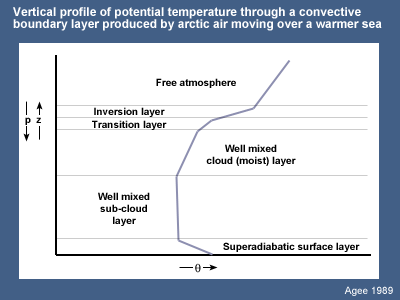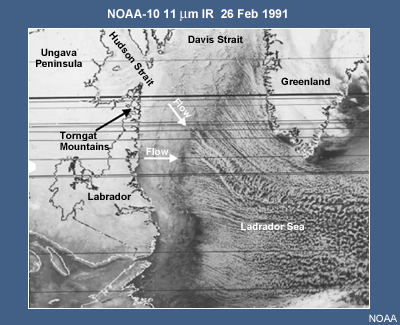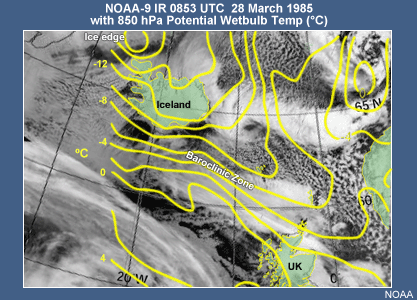1.1.4 Cold Upper Troughs and Cold Lows
If a low-level baroclinic wave, barotropic shear vortices, or areas of enhanced convection have formed in a cold
air mass, when will further development occur, if at all?
Rasmussen (1992) states, "In the case of a straight upper-level flow with little or small vorticity
advection, polar lows will not develop even in cases when the upper-level temperatures are very low.” With
this in mind we must look for forcing mechanisms. One obvious mechanism at northern latitudes is the cold upper
trough and/or closed, cold-core upper vortex.
Rasmussen (1996) states that all of the polar lows he has investigated in the Labrador Sea were initiated by a
cold upper trough or vortex. Furthermore, all of the cases investigated by Parker and Hudson (1991) and Parker
(1992) involved a cold trough and/or closed vortex at the 500hPa level. In the Pacific, a comma cloud often
accompanies the upper trough and can aid in early detection of a forcing mechanism.
A study by Noer et al. (2003) on the formation of polar lows in the Norwegian Sea area shows that in all cases a
cold upper trough or vortex was associated with the low development. Indeed, it can often be shown that the
movement and strength of this upper forcing can give good guidance on the subsequent evolution and motion of the
system.
References
Agee, Ernest M. and Steven R. Gilbert, 1989: An aircraft investigation of mesoscale convection over Lake Michigan
during the 10 January 1984 cold air outbreak. J. Atmos. Sci., 46, No.13, 1877–1897.
Bader, M.J., G.S. Forbes, J.R. Grant, R.B.E. Lilley, and A.J. Waters, 1995: Images in Weather Forecasting.
Cambridge University Press.
Charney, J. and A. Eliassen, 1964: On the growth of the hurricane depression. J. Atmos. Sci., 21,
68-75.
Emanuel, Kerry, A., 1986: A two stage air sea interaction theory for polar lows. Proc., The Third
International Conference on Polar Lows, Norway.
Emanuel, Kerry A. and Richard Rotunno, 1989: Polar lows as arctic hurricanes. Tellus, 41A, 1-17.
Noer, G. and M. Ovhed, 2003: Forecasting of polar lows in the Norwegian and the Barents Sea. Proc. of the 9th
meeting of the EGS Polar Lows Working Group, Cambridge, UK.
Harrold, T.W. and K.A. Browning, 1969: The polar low as a baroclinic disturbance. Quart. J. Roy. Meteor.
Soc., 95, 710-723.
Holton, James, R., 1992: Introduction to Dynamic Meteorology. 3d ed. Academic Press Ltd., London, U.K..
Mullen, S., 1983: Explosive cyclogenesis associated with cyclones in polar air streams. Mon. Wea. Rev.,
111, 1537-1553.
Parker, M.N. and Edward Hudson, 1991: Polar Low Handbook for Canadian Meteorologists. Environment Canada,
Atmospheric Environment Service.
Parker, Neil, 1997: Cold Air Vortices and Polar Low Handbook for Canadian Meteorlogists. Environment
Canada.
Parker, M.N, 1992: Polar lows in the Beaufort Sea and Davis Strait. Proc. Applications of New Forms of
Satellite Data in Polar Low Research, Polar Low Workshop, Hvanneyri, Iceland.
Rasmussen, Erik A. and P.D. Aakjær, 1989: Two polar lows affecting Denmark. Vejret, Special Issue in
English, The Danish Meteorological Society.
Rasmussen, Erik A., John Turner, and Paul Twitchell, 1992: Applications of new forms of satellite data in polar
low research. Bull. Amer. Meteor. Soc., 74, 1057-1073.
Rasmussen, Erik A. and Anette Cederskov, 1994: Polar lows: A critical analysis. The life cycles of extratropical
cyclones. Vol 111. Proc. of an International Symposium, Bergan, Norway.
Rasmussen, Erik A., Chantal Claud, and James F. Purdom, 1996: Labrador Sea polar lows. The Global Atmosphere
and Ocean System, Vol. 4, 275-333.
Shapiro, M.A., T. Hampel, and L.S. Fedor, 1989: Research aircraft observations of an arctic front over the
Barents Seas. Polar and Arctic Lows, Polar and Arctic Lows. Twitchell, P., E. Rasmussen, K. Davidson, Eds.,
A. Deepak Publishing.



